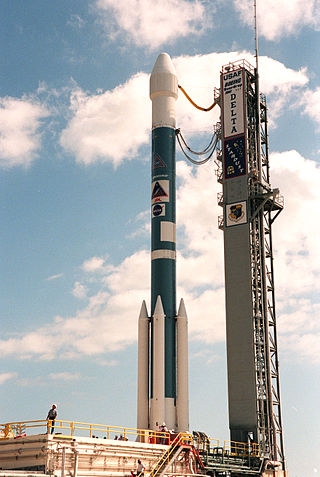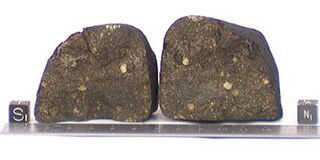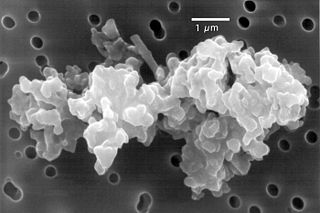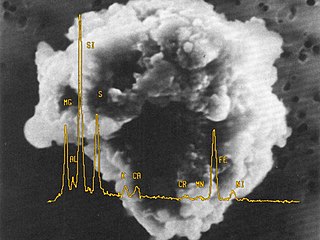Related Research Articles
Geochemistry is the science that uses the tools and principles of chemistry to explain the mechanisms behind major geological systems such as the Earth's crust and its oceans. The realm of geochemistry extends beyond the Earth, encompassing the entire Solar System, and has made important contributions to the understanding of a number of processes including mantle convection, the formation of planets and the origins of granite and basalt. It is an integrated field of chemistry and geology.
In physics, natural abundance (NA) refers to the abundance of isotopes of a chemical element as naturally found on a planet. The relative atomic mass of these isotopes is the atomic weight listed for the element in the periodic table. The abundance of an isotope varies from planet to planet, and even from place to place on the Earth, but remains relatively constant in time.

Stardust was a 385-kilogram robotic space probe launched by NASA on 7 February 1999. Its primary mission was to collect dust samples from the coma of comet Wild 2, as well as samples of cosmic dust, and return them to Earth for analysis. It was the first sample return mission of its kind. En route to Comet Wild 2, it also flew by and studied the asteroid 5535 Annefrank. The primary mission was successfully completed on 15 January 2006 when the sample return capsule returned to Earth.

Comet 81P/Wild, also known as Wild 2, is a comet named after Swiss astronomer Paul Wild, who discovered it on January 6, 1978, using a 40-cm Schmidt telescope at Zimmerwald, Switzerland.

A calcium–aluminium-rich inclusion or Ca–Al-rich inclusion (CAI) is a submillimeter- to centimeter-sized light-colored calcium- and aluminium-rich inclusion found in carbonaceous chondrite meteorites. The four CAIs that have been dated using the Pb-Pb chronometer yield a weighted mean age of 4567.30 ± 0.16 Myr. As CAIs are the oldest dated solids, this age is commonly used to define the age of the Solar System.

Presolar grains are interstellar solid matter in the form of tiny solid grains that originated at a time before the Sun was formed. Presolar stardust grains formed within outflowing and cooling gases from earlier presolar stars.

Cosmochemistry or chemical cosmology is the study of the chemical composition of matter in the universe and the processes that led to those compositions. This is done primarily through the study of the chemical composition of meteorites and other physical samples. Given that the asteroid parent bodies of meteorites were some of the first solid material to condense from the early solar nebula, cosmochemists are generally, but not exclusively, concerned with the objects contained within the Solar System.

A chondrite is a stony (non-metallic) meteorite that has not been modified, by either melting or differentiation of the parent body. They are formed when various types of dust and small grains in the early Solar System accreted to form primitive asteroids. Some such bodies that are captured in the planet's gravity well become the most common type of meteorite by arriving on a trajectory toward the planet's surface. Estimates for their contribution to the total meteorite population vary between 85.7% and 86.2%.

Cosmic dust – also called extraterrestrial dust, space dust, or star dust – is dust that occurs in outer space or has fallen onto Earth. Most cosmic dust particles measure between a few molecules and 0.1 mm (100 μm), such as micrometeoroids. Larger particles are called meteoroids. Cosmic dust can be further distinguished by its astronomical location: intergalactic dust, interstellar dust, interplanetary dust, and circumplanetary dust. There are several methods to obtain space dust measurement.
The interplanetary dust cloud, or zodiacal cloud, consists of cosmic dust that pervades the space between planets within planetary systems, such as the Solar System. This system of particles has been studied for many years in order to understand its nature, origin, and relationship to larger bodies. There are several methods to obtain space dust measurement.
Comet dust refers to cosmic dust that originates from a comet. Comet dust can provide clues to comets' origin. When the Earth passes through a comet dust trail, it can produce a meteor shower.

Extraterrestrial material refers to natural objects now on Earth that originated in outer space. Such materials include cosmic dust and meteorites, as well as samples brought to Earth by sample return missions from the Moon, asteroids and comets, as well as solar wind particles.
Aluminium-26 is a radioactive isotope of the chemical element aluminium, decaying by either positron emission or electron capture to stable magnesium-26. The half-life of 26Al is 717,000 years. This is far too short for the isotope to survive as a primordial nuclide, but a small amount of it is produced by collisions of atoms with cosmic ray protons.
Meteoritics & Planetary Science is a monthly peer-reviewed scientific journal published by Wiley-Blackwell on behalf of the Meteoritical Society. It specialises in the fields of meteoritics and planetary science.
In planetary science, any material that has a relatively high equilibrium condensation temperature is called refractory. The opposite of refractory is volatile.
CI chondrites, also called C1 chondrites or Ivuna-type carbonaceous chondrites, are a group of rare carbonaceous chondrite, a type of stony meteorite. They are named after the Ivuna meteorite, the type specimen. CI chondrites have been recovered in France, Canada, India, and Tanzania. Their overall chemical composition closely resembles the elemental composition of the Sun, more so than any other type of meteorite.

Donald Delbert Clayton was an American astrophysicist whose most visible achievement was the prediction from nucleosynthesis theory that supernovae are intensely radioactive. That earned Clayton the NASA Exceptional Scientific Achievement Medal (1992) for “theoretical astrophysics related to the formation of (chemical) elements in the explosions of stars and to the observable products of these explosions”. Supernovae thereafter became the most important stellar events in astronomy owing to their profoundly radioactive nature. Not only did Clayton discover radioactive nucleosynthesis during explosive silicon burning in stars but he also predicted a new type of astronomy based on it, namely the associated gamma-ray line radiation emitted by matter ejected from supernovae. That paper was selected as one of the fifty most influential papers in astronomy during the twentieth century for the Centennial Volume of the American Astronomical Society. He gathered support from influential astronomers and physicists for a new NASA budget item for a gamma-ray-observatory satellite, achieving successful funding for Compton Gamma Ray Observatory. With his focus on radioactive supernova gas Clayton discovered a new chemical pathway causing carbon dust to condense there by a process that is activated by the radioactivity.
CM chondrites are a group of chondritic meteorites which resemble their type specimen, the Mighei meteorite. The CM is the most commonly recovered group of the 'carbonaceous chondrite' class of meteorites, though all are rarer in collections than ordinary chondrites.

Dust astronomy is a subfield of astronomy that uses the information contained in individual cosmic dust particles ranging from their dynamical state to its isotopic, elemental, molecular, and mineralogical composition in order to obtain information on the astronomical objects occurring in outer space. Dust astronomy overlaps with the fields of Planetary science, Cosmochemistry, and Astrobiology.
References
- ↑ "Geophysical Sciences". geosci.uchicago.edu.
- 1 2 "6947 Andrewdavis (1981 ET8)". Minor Planet Center. Retrieved 18 July 2019.
- ↑ "AAAS Honors Accomplished Scientists as 2018 Elected Fellows". American Association for the Advancement of Science.
- ↑ "MPC/MPO/MPS Archive". Minor Planet Center. Retrieved 18 July 2019.